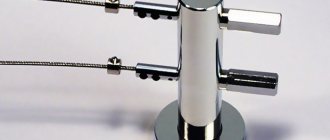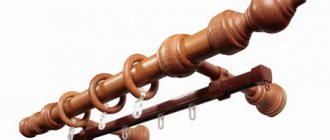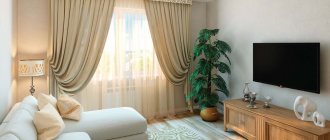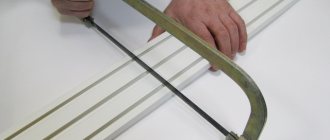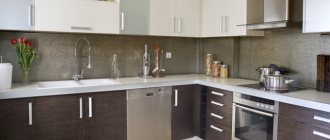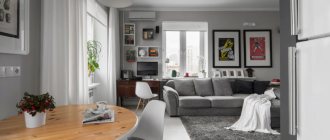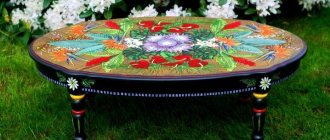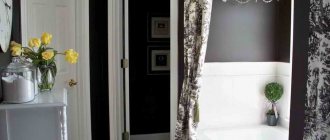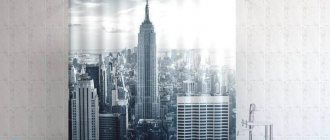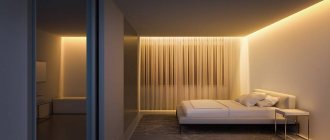Home / Components and accessories / Types and advantages of flexible curtain rods
In some situations, it is not possible to use traditional curtains to attach curtains - this mainly happens when windows are located in bay windows. Ordinary cornices are not suitable here, since the wall line is curved and straight rigid guides will have to be attached with a broken line, which will not decorate the appearance of the window. In this case, a flexible curtain rod would be the ideal solution for hanging curtains.
Varieties and differences from standard solutions
Basically, there are only two types of such systems: aluminum and plastic. The former allow you to hang heavier curtains, however, the strength of polymer structures is practically not inferior to them.
Another difference will be the possibility of attaching a lambrequin, which is not provided for all models. The presence of such a mount will allow you to hide the curtain itself from view. Any flexible cornice can be mounted on a wall or ceiling according to your wishes.
Unlike standard curtains, the number of guides for attaching curtains here is limited only by the width of the bracket on which they are attached, if the fixation is supposed to be on the wall. In the case of placement on the ceiling surface, you can mount as many identical guides as you like.
Interior use of flexible curtain rod
It is clear that such an original element could not leave designers and interior decorators indifferent. What application have flexible curtain rods found in modern homes, in what interiors and styles are they used?
- Flexible cornices have become a favorite way to decorate bay windows. Thanks to the ability to support multi-level curtain designs, flexible curtain rods can be used to create lush and solemn compositions in the Empire style, and for light, weightless designs in a modern style. The possibility of maximum bending of the structure provides ample opportunities for decorating both spacious three- and five-window bay windows, as well as very modest niches with one window.
- Flexible cornices look good in the decoration of roof windows, loggias and balconies. The combination of straight drapes made of dense, smooth-weave materials and light tulle curtains creates a clean, cool image of window openings that is especially close to Californian and Mediterranean style, and also fits perfectly into Northern European interior variations.
- Flexible curtain rods are used not only in window decoration. They will perfectly help to highlight doorways, or even replace traditional doors. The curved shapes of flexible cornices are especially popular for zoning the area in a studio apartment or in a kitchen-dining room. Moreover, the curtains that are attached to such cornices do not necessarily have to be curtains or drapes all the way to the floor. This could be a playful arch curtain made of bright chintz, or romantic thread curtains made from several types of colored strands. Curtains made of beads also look beautiful as a space divider, and a flexible cornice will only emphasize their elegant beauty.
- Flexible curtain rods are indispensable for arranging a variety of screens and canopies, which are especially popular in the design of bedrooms. Such a cornice allows you to create, without exaggeration, any form of canopy. In bedrooms made in a classic design, a simple rounded cornice with light, translucent fabrics looks beautiful. In a room decorated with pretensions to luxury, it is quite appropriate to use more fantasy variations. For example, a double wave, or an S-shaped cornice. Loose, heavy fabrics with embroidery or gilding can be attached to it. In a spacious bedroom of modern design, a spiral around the bed with a curtain made of smooth plain fabric with a large pattern or original geometric prints will look interesting.
- In children's rooms, flexible curtain rods are also used to make canopies over the cribs of young princesses. As a rule, a simply rounded or wavy cornice is sufficient. The fabrics for such a canopy are selected to be light and translucent, so you can purchase a plastic cornice designed for lightweight structures.
- Sometimes flexible curtain rods can even be found in the bathroom. They are used for zoning bathtubs of non-standard shape: corner, semicircular, drop-shaped. Special curtains that are resistant to splashes of water and steam are attached to the cornices.
As you can see, flexible curtain rods open up wide spaces for interior imagination. However, this is not only an original design element, but also a very practical way to design non-standard openings and walls with complex terrain. In addition, flexible curtain rods will perfectly cope with zoning and dividing any premises - from studio apartments to bathrooms.
Equipment and appearance
The kit for this curtain hanger includes approximately the following set of components:
- Aluminum or polymer guide on which the runners are mounted
- Brackets for fixing the cornice on the wall or ceiling
- Runners on which hooks for curtains are attached
- End caps for guide
The set may vary and include additional components. This is possible when purchasing a solution that provides for mounting a lambrequin. Also, for curtains that are too heavy, you can additionally purchase reinforcing supports that increase the maximum permissible weight of the suspended material.
You can see how such a curtain rod looks after assembly and installation in several photos below.
Pros of use
The main advantage of such solutions is the possibility of bending the suspension line. Undoubtedly, in cases with bay windows, this option is much preferable to conventional straight curtains. However, besides this, the use of flexible solutions has other positive aspects:
- Possibility of visually increasing space due to installation on the ceiling surface
- Compact dimensions make the suspension almost invisible
- Ease of installation allows you to do the installation without outside help
- There are both wall and ceiling flexible curtain rods
- The design will withstand even heavy curtains
- Maintenance is practically not required - almost no dust accumulates on such structures
- The curtain slides easily from one edge of the track to the other without any difficulty
- Even plastic guides can easily withstand a 90-degree bend without breaking.
- The length can be reduced by cutting off the excess, or increased by using a connector and an extension element
- The cost is not too high
- A flexible curtain rod will be an excellent option for a bathroom in which the bathtub itself is not located between two walls, but in another way - the curtain can even be hung around it
Advantages of using flexible curtain rods in the interior
The original shape is not the only advantage of this type of cornices. Flexible curtain rods have a lot of advantages that provide lasting interest to consumers.
- The flexible curtain rod is easy to transport and store. Rolled into a ring, it takes up minimal space, both in transport and at home, awaiting final strengthening in the right place.
- Installation of such a cornice is also simple and does not require any special tools or skills. Any home craftsman can handle attaching cornices.
- The cost-effectiveness of the design is another argument in favor of a flexible cornice. The aluminum version is slightly more expensive than the plastic one, but it can withstand the weight of curtains up to 50 kg. But the plastic version allows you to bend the curtain structure at an angle of 95 degrees.
- This type of curtain fastenings can be easily shortened to the desired size, and, if necessary, can be extended using special couplings. With their help, the profile increases to almost any length. However, it must be remembered that the longer the cornice, the shorter the pitch of the mounting brackets should be. Otherwise, the structure will lose stability.
- A flexible cornice will perfectly cope with the design of non-standard window openings, various niches, and complex room topography. It can be used to bend around a column or pipe. So this type of fastener is indispensable not only for creating whimsical design compositions, but also for use in rooms of complex shapes.
- This type of cornice allows you to perfectly design a window opening, as well as successfully zone a room, highlight, or, conversely, disguise certain areas of the room.
How to attach
There is nothing complicated in this process. It is important to correctly mark the wall or ceiling along which the holes for fixing the brackets will be drilled. If the structure is to be mounted on the wall, you need to check the horizontal position of all the holes and adjust the length of the wall mount so that the hanging curtain does not touch the window sill.
Attaching a flexible ceiling cornice is a little more difficult, but only because you have to work with the ceiling surface. As in the case of the wall option, marking is of great importance here. It is necessary to mark the points where the holes will be drilled so that after hanging, the curtain does not touch the window sill. The line of the cornice most often follows the contour of the wall.
After the holes are drilled, it is time to fix the brackets. After installation, a guide with sliders is attached to them. It is better to cut off the excess length after it is in place. All that remains is to put caps on the ends of the rods and hang the curtains.
Flexible ceiling cornices: find out the features
When decorating rooms, it is important to follow the general stylistic direction, while correctly placing interior accents. For this purpose, window textiles are used, which act as a connecting link for many design elements.
Window decoration in the living room
Curtains and curtains require appropriate fastening. If ordinary consoles are suitable for simple rooms without complex geometry, then for rooms with rounded walls or bay windows only a flexible curtain rod is acceptable.
Structurally, this element is a long plinth made of polymer material. This raw material provides the cornice with elasticity and flexibility. Polyurethane is similar to rubber, but has the following useful characteristics: insensitive to heat and cold, not afraid of exposure to chemicals, wear-resistant, and has an affordable price.
A bendable curtain rod can be made of aluminum. The material is resistant to deformation, has a wide range, and an impressive appearance. It is durable and reliable, but costs more than plastic.
Purpose and features
A curved curtain rod is used when decorating complex rooms with bay windows; used for canopies, niches; when dividing a room into zones; for decorating loggias, balconies and attics, as well as when decorating atypical doors.
The advantages of the product include the following characteristics:
- reasonable price;
- extensive product range;
- simplified installation, accessible to any user;
- creating a stylish design;
- use of the product in the living room, bedrooms, kitchen and bathroom;
- strength of the material, along with elasticity;
- decent level of quality of polymer products;
- sliding of canvases along guides without hitches, etc.
The material bends up to 50 mm in 5 minutes, and, if necessary, forms an angle of up to 100 degrees. The flexible polyurethane cornice can easily support heavy textile structures weighing up to 80 kg.
The functional purpose of such a product is to play with non-standard walls and window openings. At the same time, a flexible universal curtain rod helps hide joints or irregularities in the space between the wall and the ceiling. In addition to practical benefits, elastic curtain rods round corners in the room. According to psychologists, this has a beneficial effect on a person’s mood: it gives him comfort and security.
Flexible cornice
Classification
Flexible curtain rods are:
It is advisable to use ceiling consoles if the ceilings in the room are not high enough (such cornices visually stretch the space vertically). There is no big difference between the two options, including issues with installation.
Installing a curved ceiling cornice is strictly not recommended in the case of a suspended ceiling!
According to the bending method, there are cornices bent in the form of a wave (in a bay window) or in a semicircle similar to an arch. It happens that these 2 types of folds are combined in one console. Then the product has only one row for hanging textile products.
Based on complexity, products are divided into single-row and multi-row. The first type is used in the case of the simplest window composition, which involves the use of one curtain or curtain fabric. The second is used for complex textile compositions of drapes and thin curtains hung in several rows.
Arc-shaped curtain rods are equipped as follows:
- elastic profile;
- supports (bracket holders that secure the product to the wall or ceiling using a movable element);
- curtain runners with stoppers in the form of plugs, which have 2 rows of special hooks;
- extension cord (for universal designs).
There are 2 types of runners for elastic consoles: bottom (for medium and light weight fabrics); top (for hanging curtains with lambrequins).
If the structure is correctly assembled and installed without errors, the curtains should move freely along the guides in the direction specified by the user, without stopping at the point of bending. This is achieved by balancing the weight of the fabric vertically.
Application in the interior
Flexible consoles are often used to decorate window openings in living rooms, bedrooms or studio apartments. Thanks to complex structures, a unique room design is obtained, based on rounded lines or smooth transitions.
Using an element such as a flexible cornice, hangers in the form of canopies are installed and screens are built. If you want to decorate your bathroom attractively, use a curved cornice on which a moisture-resistant curtain is hung.
Installation
For work, stock up on a drill, hammer drill, screwdriver, special glue, fasteners (dowels, screws), pencil, tape measure and level. Be sure to read the instructions for the product.
The algorithm for installing a ceiling elastic cornice is as follows:
- Project development.
- Drawing the bending path on the ceiling.
- Drilling holes at 500mm intervals for the calipers, following the direction of the drawn line.
- Attaching runners with rollers to the base.
- Fastening brackets (calipers).
- Fixing the profile on the brackets (at this stage you need to bend the curtain rod).
- Installation of plugs at the ends of the structure.
- Attaching hooks.
- Hanging curtains with an elastic system.
Important tips for installation
If you plan to attach a flexible curtain rod with glue, it is better to do this on a plastered wall before applying wallpaper and painting the ceiling surface. The surface must first be cleaned and degreased by treating with an alkaline solution (White diluted in water).
To enhance adhesion to the baseboard, the wall surface is treated with a primer or primer.
The cornice is cut into the necessary pieces with a sharp stationery knife, and a carpentry tool, a miter box, is used as a guide.
httpv://youtu.be/XXWh5i01ipk
If you plan to glue parts of the cornice together, they are glued not only to the ceiling, but also with their ends facing each other.
But more often, cornices are mounted with self-tapping screws, which do not require special preparation of the ceiling. Along with the installation of cornices, you can install diode strips, giving the room a unique coziness and fairy-tale charm.
podborshtor.ru
